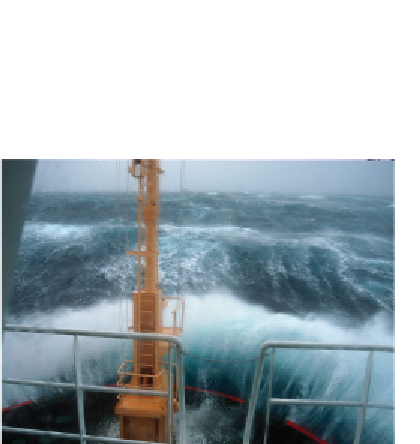Geoscience Reference
In-Depth Information
Figure 5.3
Waves in the Southern Ocean breaking
over the ship
'
s bows. (Credit: Peter Bucktrout, BAS)
flowing Antarctic
Coastal Current is related to the East Wind
Drift.
The West Wind Drift, with its frequently very
strong winds and highwaves, has been a problem
for sailors and explorers since the early days of
exploration and navigation in the southern
hemisphere. Between 45
Sand55
Swherethe
strongest winds are found, gale force winds can occur as frequently as 20% of the time.
The sailing conditions of the Southern Ocean are re
Current, whilst the westward
ected by terms such as
'
Roaring
Forties
. Since the low pressure systems are
of the same size (around 1000 km across) and the same intensity in both the southern
and northern hemispheres, and since the wave height depends on the distance and
the time over which the wind is blowing in the same direction, these wind-generated
waves are actually of a similar height in the Southern Ocean and the North Atlantic
or North Paci
'
,
'
Furious Fifties
'
and
'
Screaming Sixties
'
c. The largest wave heights normally to be expected in the West Wind
Drift are 25m but under particular conditions even larger waves may be formed. In
certain areas, for example at the southern tips of South Africa and South America,
superposition of waves originating from different wind systems can interact with ocean
currents to generate extremely high waves, monster waves. South of Africa interference
of waves from the Indian and the Atlantic Oceans might lead to wave heights of 35m.
Most likely such
'
monster waves
'
occur more often than was believed in the past based
on ship
s observations only, but satellite detection of such events started only recently.
The enormous circumpolar extent of the Southern Ocean allows the swell,
i.e. the waves which propagate out of the wind-driven area, to travel farther than
in the limited northern oceans before reaching coasts. This holds in particular for the
relatively narrow North Atlantic. Swell higher than 4m is present for 30 to 70%
of the time between 50
S and 60
S. Since the winds are weaker in summer, high
seas and swell are most frequent in autumn, winter and spring.
The winds in the Antarctic coastal area are strongly in
'
uenced by the winds
blowing down to the coast from the interior of the continent. With an average
height of 2500m, Antarctica is the highest of all continents. High pressure air sinks
over the continent, cools to become denser and then
flows steadily down-slope by
gravity towards the coast. This down-slope motion, the katabatic winds, can
reach dramatic speeds. The strongest winds ever measured in Antarctica were the
katabatic winds at Dumont d
Urville with a speed of 327 kmh
-
1
. The superposition
'



Search WWH ::

Custom Search